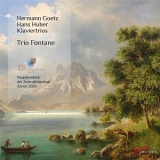Der Schweizer Hans Huber (1852-1921) hat vier Klaviertrios komponiert. Das erste, sein Opus 20, wurde 1880 uraufgeführt. Der Solothurner, der am Leipziger Konservatorium Komposition bei Carl Reinecke studiert hatte, und später in Basel, eine wichtige Rolle im Musikleben der Stadt spielte, bekam vom Göttinger Musikdirektor Eduard Hille eine sehr gute Kritik: « Bisher kamen mir von dem begabten Komponisten nur Klaviersachen in kleinerem Rahmen zu Gesicht, die mir sehr gefielen. Hier liegt nun ein größeres Werk von ihm vor, an das ich mit besonderer Erwartung herangetreten bin. Wer sich ohne Voreingenommenheit in das Werk versenkt, der wird seine Freude an ihm haben. Es ist durchweg edel gehalten, warm empfunden und eigentümlich erfunden; es geht einen besonderen Weg, der gelegentlich wohl an Dornen vorbeiführt, sonst aber rechts und links des Schönen nicht wenig finden lässt. Über dem Ganzen lagert ein poetischer Duft, der uns das Werk immer lieber werden lässt. »
Das spätromantische Werk ist zwar kaum dornig, zumindest nicht für Ohren aus dem 21. Jahrhundert, aber es ist gewiss sehr gefällig. Das Trio Fontane spielt es zupackend und klangvoll.
Hermann Goetz (1840-1876) studierte zunächst Theologie und Mathematik in seiner Heimatstadt Königsberg. Schließlich wechselte er zur Musik und besuchte das Stern-Konservatorium in Berlin, wo er bei dem Gründer Julius Stern sowie bei Hans von Bülow und Hugo Ulrich studierte. 1862 trat er die Nachfolge Theodor Kirchners als Organist an der Kirche in Winterthur an.
Sein einziges Klaviertrio op. 1, Hans von Bülow gewidmet, stammt aus dem Jahr 1867. In der Verlagsnotiz heißt es: « Der Kopfsatz des Trios, Adagio-Con fuoco, beginnt mit einer langsamen und grüblerischen Einleitung. Darauf folgt der hochdramatische und emotionale Hauptteil, der das in der Einleitung angedeutete Versprechen voll und ganz einlöst. Als nächstes folgt ein langsames, abschiednehmendes Adagio, Molto tranquillo. Besonders schön ist die duettartige Streicherführung. Der dritte Satz, Leggiero ma agitato, ist ein originell klingendes Scherzo. Das Finale, Allegro moderato, vivace, beginnt ebenfalls grüblerisch mit Schattierungen des Mendelssohn-Trios op. 49, aber ein sonniges zweites Thema vertreibt schnell die Wolken. »
Das Trio Fontane sorgt für eine gute musikalische Aufführung, die in den schnellen Sätzen durch einen schwungvollen, virtuosen aber immer auch ausgeatmeten Vortragsgestus, im langsamen Satz durch eine sehr anmutige Stimmung gefällt.
























